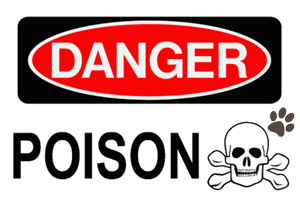Six Backyard Dangers for Your Pets

Spring has arrived and summer is just around the corner and our pets will be spending more times outdoors with us while we garden, barbecue and just enjoy the sun. Here are some of the most common potentially harmful dangers for pets that should be avoided in many yards and gardens:
Spring has arrived and summer is just around the corner and our pets will be spending more times outdoors with us while we garden, barbecue and just enjoy the sun. Here are some of the most common potentially harmful dangers for pets that should be avoided in many yards and gardens:
1. Mulch Products - That brown cocoa bean mulch is made of discarded hulls or shells of the cocoa bean, which are by-products of chocolate production. The tempting "chocolate-like" smell is enticing to your pets. Since it is not usually apparent how much of the toxin the mulch contains, it's best to keep dogs a safe distance away, to always supervise your pet while outside, or to not use that particular type of mulch at all.
2. Fertilizers, Soil Additives and Pesticides - While some fertilizers can be safe for pets, those that contain blood meal, bone meal, feather meal and iron may be especially tasty - and dangerous to dogs. Large ingestion of the meal-containing products can form a concretion in the stomach, potentially obstructing the gastrointestinal tract and causing severe pancreatitis, and those that contain iron may result in iron poisoning. Always read the labels to ensure proper usage and safety precautions with your pets.
3. Slug and Snail Baits - These can be pesty creatures. Baits are available in a variety of forms (pellets, granular, powder and liquid) and contain the active ingredient metaldehyde, which is highly poisonous to dogs and cats. These baits are highly toxic and without immediate veterinary attention, symptoms can last for several days and can be fatal.
4. Compost - This seems like a very healthy substance and gardeners love their compost; however, it can be toxic to pets and wildlife so please keep it fenced off. As the organic matter decomposes, it is common for molds to grow, some of which produce tremorgenic mycotoxins, which are toxic to both pets and wildlife. Even small amounts ingested can result in a sick pet within 30 minutes to several hours. Signs of ingestion include agitation, hyperthermia, hyper-responsiveness, panting, drooling, and vomiting, and can progress to serious issues like including incoordination, tremors, and seizures!
5. Blue–green algae or Cyanobacteria - We all love to sit by water but the growth of toxic algae can be found in both fresh and salt water throughout the warm regions of the world. Blue-green algae becomes concerning when algae accumulates on the surface of the water during hot, dry weather with wind that can shift concentrated algae mats along the shorelines. Affected water may have the appearance of pea soup with thick layers of algae on the surface. Blooms of blue-green algae can contain hepatoxins and/or neurotoxins, depending on the species. Exposures occur when dogs ingest or swim in water that contains the cyanobateria which can cause vomiting, diarrhea, lethargy, weakness, shock, icterus (yellow gums), and potentially death within 24 hours to several days.
6. Flowers and Plants - While many herbs are great for your pets, some of the most dangerous spring and summertime threats to pets in the yard are common flowers and plants:
---Lily of the Valley: An early springtime favorite, the Lily of the Valley (Convallaria majalis) contains cardiac glycosides, which are also used in many human heart medications. Any pet with a known exposure should be examined and evaluated by a veterinarian and treated symptomatically.
---Crocuses: There are two types of crocus plants: one blooms in the spring and the other in the fall. The spring plants are more common and cause only gastrointestinal upset accompanied by vomiting and diarrhea in dogs and cats. However, the fall crocus is highly toxic and can cause severe vomiting, gastrointestinal bleeding, and multi-system organ failure with bone marrow suppression.If you witness your pet eating a crocus and you are not sure what variety it is, seek veterinary care immediately.
---Lilies: Cat owners beware of lilies! While some types cause only minor symptoms when eaten, other varieties of the true lily family are deadly and highly toxic to cats; even the water in a vase containing true lilies is considered highly poisonous. If a cat consumes any part of these lilies, he or she needs immediate veterinary care to prevent kidney failure.
Enjoy the time outdoors with your pets just be careful of what you leave out and what they put in there mouths. Also make sure that your pets have access to shade and water during those hot summer days.
Source: Pet Poison Hot line


Comments
Be the first to comment...